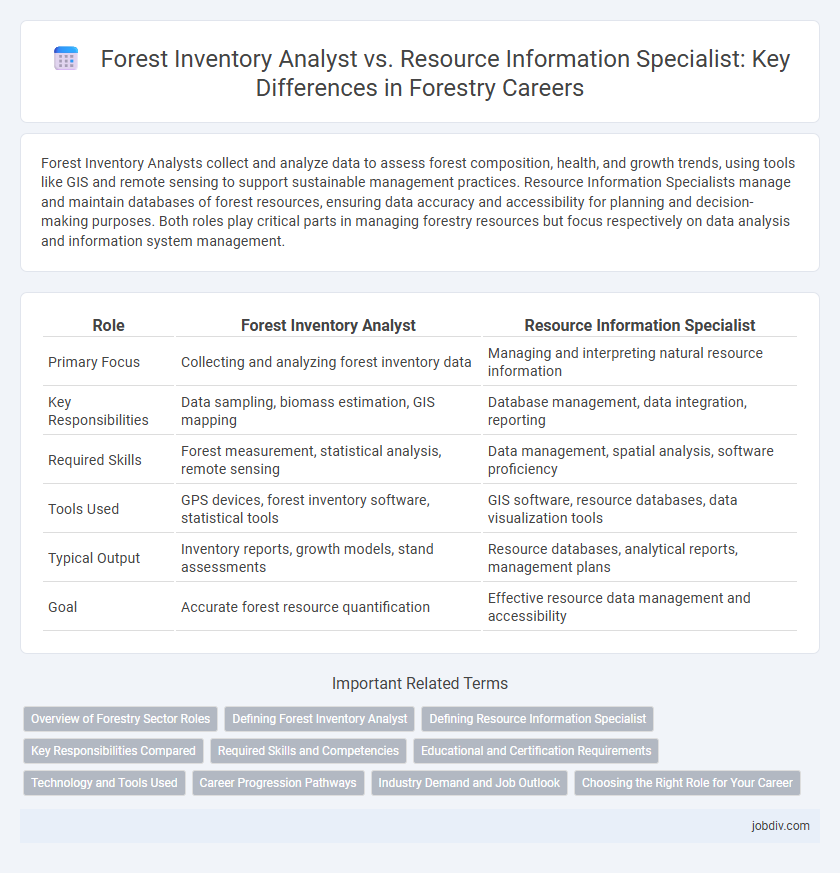Forest Inventory Analysts collect and analyze data to assess forest composition, health, and growth trends, using tools like GIS and remote sensing to support sustainable management practices. Resource Information Specialists manage and maintain databases of forest resources, ensuring data accuracy and accessibility for planning and decision-making purposes. Both roles play critical parts in managing forestry resources but focus respectively on data analysis and information system management.
Table of Comparison
| Role | Forest Inventory Analyst | Resource Information Specialist |
|---|---|---|
| Primary Focus | Collecting and analyzing forest inventory data | Managing and interpreting natural resource information |
| Key Responsibilities | Data sampling, biomass estimation, GIS mapping | Database management, data integration, reporting |
| Required Skills | Forest measurement, statistical analysis, remote sensing | Data management, spatial analysis, software proficiency |
| Tools Used | GPS devices, forest inventory software, statistical tools | GIS software, resource databases, data visualization tools |
| Typical Output | Inventory reports, growth models, stand assessments | Resource databases, analytical reports, management plans |
| Goal | Accurate forest resource quantification | Effective resource data management and accessibility |
Overview of Forestry Sector Roles
Forest Inventory Analysts specialize in collecting, analyzing, and interpreting data on forest resources to support sustainable management and conservation efforts. Resource Information Specialists manage and maintain databases related to forestry resources, providing critical information for decision-making and policy development. Both roles are essential in the forestry sector, combining fieldwork expertise with advanced data management to ensure accurate resource assessments and support environmental stewardship.
Defining Forest Inventory Analyst
A Forest Inventory Analyst specializes in collecting, managing, and analyzing forest data to assess timber volume, health, and growth patterns using advanced GIS and remote sensing technologies. This role requires expertise in statistical methods and forest measurement techniques to support sustainable forest management decisions. Unlike a Resource Information Specialist, who may focus more broadly on various natural resource data, the Forest Inventory Analyst is specifically dedicated to forest inventory accuracy and data-driven forestry operations.
Defining Resource Information Specialist
A Resource Information Specialist manages and analyzes geospatial and tabular data to support sustainable forest management and conservation planning. They utilize GIS technology, remote sensing, and database management to assess forest health, monitor wildlife habitats, and track natural resource inventories. Their role emphasizes data accuracy and integration to inform policy decisions and optimize resource allocation within forestry projects.
Key Responsibilities Compared
Forest Inventory Analysts primarily focus on collecting, analyzing, and interpreting forest data to assess tree growth, health, and volume for sustainable forest management. Resource Information Specialists manage and maintain comprehensive databases, integrating geographic information systems (GIS) and remote sensing technologies to support resource planning and decision-making. Both roles require expertise in data accuracy and reporting, but Forest Inventory Analysts emphasize field data sampling and statistical analysis, while Resource Information Specialists prioritize data integration and information system management.
Required Skills and Competencies
Forest Inventory Analysts require expertise in data collection methods, statistical analysis, and geographic information systems (GIS) to accurately assess forest resources and growth patterns. Resource Information Specialists must possess strong skills in database management, environmental modeling, and remote sensing technology to support sustainable forest management plans. Both roles demand proficiency in interpreting ecological data and communicating findings to inform conservation strategies.
Educational and Certification Requirements
Forest Inventory Analysts typically require a bachelor's degree in forestry, natural resources, or environmental science, with certifications such as the Society of American Foresters (SAF) Certified Forester credential enhancing job prospects. Resource Information Specialists often hold degrees in forestry, geography, or information science, and may benefit from certifications like GIS Professional (GISP) or Certified Mapping Scientist to support spatial data management. Both roles value strong analytical skills and proficiency in forest data collection and management technologies.
Technology and Tools Used
Forest Inventory Analysts utilize advanced remote sensing technologies such as LiDAR and satellite imagery to collect precise data on forest composition and health, often leveraging GIS software for spatial analysis and mapping. Resource Information Specialists employ integrated database management systems to organize and interpret large datasets derived from field surveys, aerial photography, and sensor networks, optimizing resource planning and conservation efforts. Both roles rely heavily on drones and GPS technology to enhance data accuracy and streamline forest resource monitoring.
Career Progression Pathways
Forest Inventory Analysts typically advance by deepening expertise in data collection technologies, spatial analysis, and forest modeling, often progressing to senior analyst or project manager roles within forestry agencies or environmental consultancies. Resource Information Specialists focus on integrating diverse environmental datasets, GIS applications, and resource management plans, enabling career growth toward resource manager or environmental planning coordinator positions. Both pathways emphasize expanding technical skills and interdisciplinary knowledge, with potential crossover opportunities in roles centering on forest resource assessment and sustainable management strategies.
Industry Demand and Job Outlook
The demand for Forest Inventory Analysts is strong due to increasing emphasis on sustainable forest management and precise data collection for timber valuation and ecological assessments. Resource Information Specialists are experiencing growing opportunities as industries rely on advanced geospatial technologies and data analytics to optimize natural resource use and conservation efforts. Both roles show positive job outlooks, with the forestry sector prioritizing data-driven decision-making to meet environmental regulations and support climate change initiatives.
Choosing the Right Role for Your Career
A Forest Inventory Analyst specializes in collecting and analyzing data on forest composition, health, and growth to support sustainable management plans, making it ideal for those with strong quantitative and GIS skills. A Resource Information Specialist manages and interprets diverse environmental databases, integrating data from wildlife, vegetation, and land use to provide comprehensive resource assessments, suited for professionals adept in data management and cross-disciplinary analysis. Choosing between these roles depends on your expertise in statistical analysis versus data integration, as well as your career goals in forest resource planning or broader environmental information management.
Forest Inventory Analyst vs Resource Information Specialist Infographic

 jobdiv.com
jobdiv.com